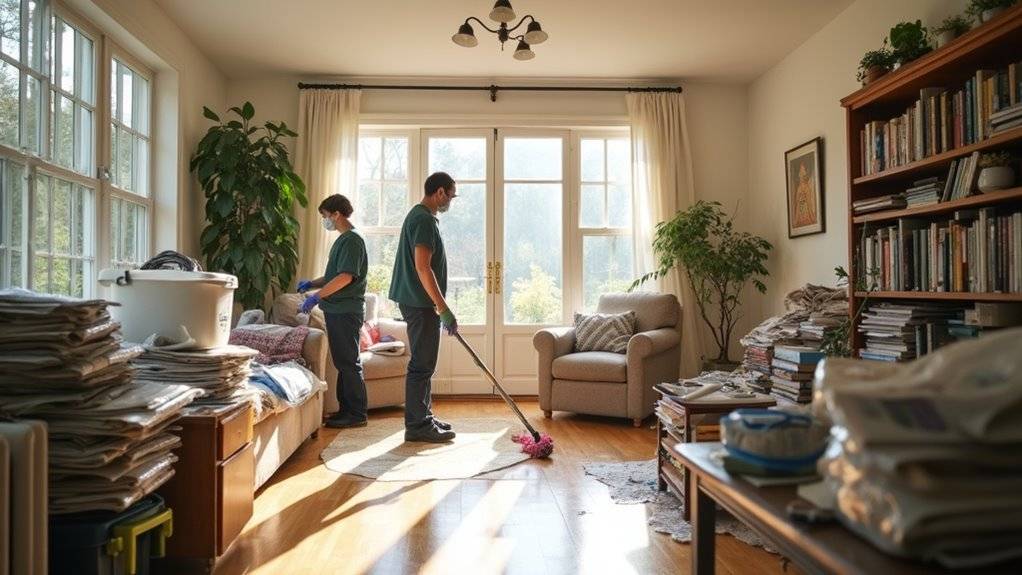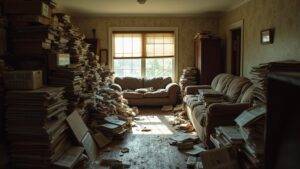Selling a hoarder house is a major challenge for any homeowner. Piles of clutter can hide serious issues like mold, pests, or structural damage. Buyers may walk away if the mess makes it hard to see the home’s true value.
The longer you wait to clean, the bigger the problem becomes. Unchecked clutter can lower your sale price and make the house unsafe. You may even face legal or health issues if you do not act soon.
The best way to clean a hoarder house before selling is to use a step-by-step plan that addresses safety, cleaning, and repairs. This approach will make the home safer and more attractive to buyers.
It will also help you sell faster and for a better price. This blog will guide you through each step to help you clear the clutter and prepare your home for sale.
Key Takeaways
- Assess the entire property for clutter, hazards, and damage to create a detailed cleanup plan and prioritize safety.
- Sort items into categories—keep, donate, discard—using labeled boxes, and finish one room before moving to the next.
- Use proper protective gear and industrial cleaning supplies to address health hazards, mold, and deep-clean all surfaces.
- Hire professional cleaners, junk removal services, or cash home buyers if the cleanup is overwhelming or time-sensitive.
- Enhance home appeal by repairing visible damage, improving air quality, and working with experienced real estate agents for a successful sale.
Assessing the Scope of the Cleanup
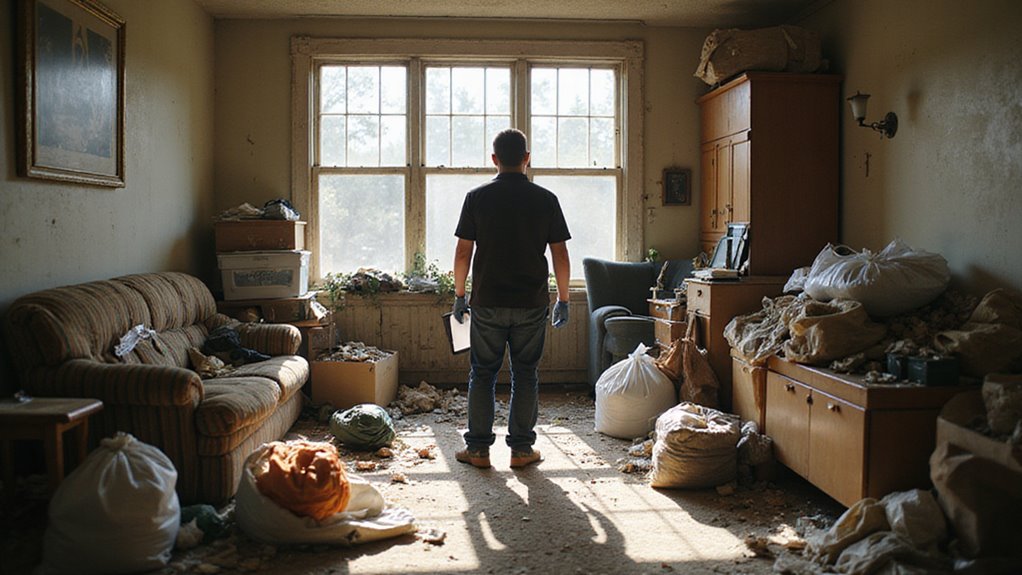
To assess the scope of the cleanup, first walk through the entire house. Take note of how much clutter is in each room. This helps you understand how much work is needed.
Check closets, bedrooms, and storage areas for heavy clutter. If you see mold, pests, or damage, plan for extra time and money. Sometimes, you may need help from professionals for these problems. If the property is owned by more than one person, keep in mind that multiple owners can add complexity to the decision-making and cleanup process.
Identify things that have sentimental value, as these need careful handling. Take photos and write down what you see in each space. This documentation helps you plan tasks and estimate the supplies you need.
If you share your findings with others, they will know what to expect. Clear communication is important if you work with realtors or cleaning teams. Careful assessment makes the cleanup process smoother.
When preparing to sell the house, it’s also important to understand capital gains taxes if you expect to make a profit from the sale.
Developing a Realistic Cleanup Plan
Now that you’ve assessed the scope of the cleanup, it’s time to create a plan that matches the reality of the work ahead. Set clear, achievable milestones so you can measure progress and keep the project on track. By breaking the job into manageable phases, you’ll avoid overwhelm and set yourself up for lasting results.
Be sure to consider legal considerations if the property is being sold under a land contract, as this can impact your selling options and cleanup decisions. Remember, if extensive repairs or overwhelming clutter make the process too daunting, selling a house as-is can be a practical alternative that saves both time and money.
Assessing Cleanup Scope
You must first understand how much cleanup is needed in a hoarder house. Walk through each room and list what should be removed, sorted, or kept. This step helps you see the amount of work ahead.
Check if the clutter is mostly paper, trash, or large items. Note any hazardous materials that may need special care. If you find dangerous items, consider calling professionals.
Remember that cleaning a hoarder house can be emotional for those involved. Offer support if someone feels attached to certain items. Planning for this makes the cleanup process smoother.
Estimate the time, help, and resources needed for the job. If you plan to sell the property, you might need more help. A clear assessment lets you create a practical cleanup plan.
Setting Achievable Milestones
Setting achievable milestones means breaking a big cleanup into smaller, manageable steps. Start by dividing the house into zones or rooms. Set a clear goal for each area, such as clearing the kitchen by Tuesday.
If you want to stay motivated, you can reward yourself after completing each milestone. Acknowledge any stress or emotional attachments during the process. Sharing your plan with others ensures everyone understands and can help.
If you set small and measurable targets, you make the task less overwhelming. This method helps you track your progress and keep moving forward. Your property will be ready for the market with less stress and more efficiency.
Gathering the Right Supplies and Equipment

To clean a hoarder house, you need the right supplies and equipment. Proper tools make the job safer and faster. Heavy-duty storage bins help with sorting items. Durable gloves, dust masks, and eye protection keep you safe from hazards.
If you expect mold or dust, always use these protective items. For especially tough jobs, you might consider consulting professional cash home buyers who are experienced with homes in challenging conditions.
Industrial trash bags are best for removing large amounts of debris. A sturdy broom, mop, and vacuum help clean all surfaces. Cleaning solutions for grime, mold, and odors are also important.
Labels and markers make organization easier. If you label bins and bags, you can track what to keep or throw away. The right supplies help you finish the job efficiently and safely.
If you need to sell quickly after cleaning, consider working with trusted cash home buyers who purchase houses as-is, saving time and effort on repairs.
Assembling a Support Team
A support team is necessary when cleaning a hoarder house. You should not attempt this project alone. The right people help you finish faster and manage stress.
Family or friends can give encouragement and help with tasks. Professional organizers know how to handle hoarding situations well. Cleaning companies can handle large cleanouts if the job is too big. For especially challenging properties, cash offers for any condition can be a practical solution, letting you sell without repairing or clearing everything.
Mental health professionals can provide support if the process becomes overwhelming. Real estate agents can offer advice on selling the house once it is clean. If you build a strong team, you make the project easier and more successful.
If the cleanup seems overwhelming, consider working with trusted home buyers who purchase homes as-is, allowing you to sell without finishing all the cleaning or repairs.
Addressing Safety and Health Hazards
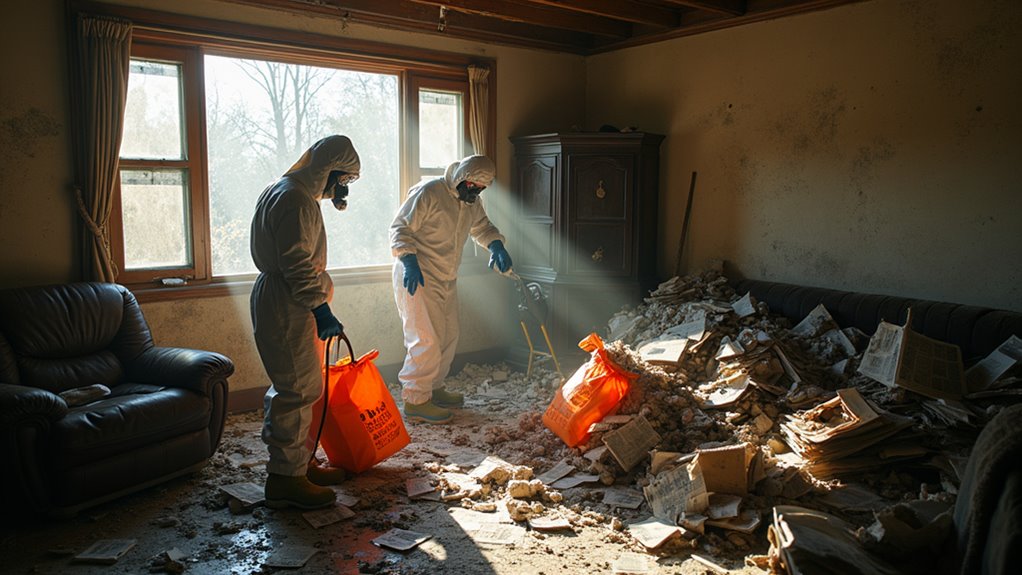
Cleaning a hoarder house comes with many safety and health risks. Workers should wear gloves, masks, and sturdy boots at all times. These steps will help protect everyone involved. Address foundation issues early, as hidden structural problems in hoarder homes can significantly decrease the property’s value and make cleaning more dangerous.
Inspect the home for hazards like mold, chemicals, sharp objects, and biohazards. If you see dangerous items, arrange for safe removal. Some materials may need professional disposal.
Look for signs of pests such as rodents or insects. These can spread disease and contaminate surfaces. Address any infestations quickly.
Check for structural problems, including weak floors or exposed wires. Adequate ventilation helps reduce airborne dangers. If a risk seems too great, call certified professionals.
Record anything needing special cleaning or repair. Early action can prevent accidents and raise the property’s value. Always prioritize safety during the cleaning process.
If you want to avoid the stress and risk of cleaning, consider working with local home buyers who purchase properties as-is and handle all repairs and clean-outs for you.
Sorting Items: Keep, Donate, Discard
You should sort all household items into three groups: keep, donate, or discard. Start in one room and finish before moving to the next. This helps you stay focused and organized.
Place items in sturdy, labeled boxes for each group. Clear labels prevent mix-ups during sorting. If you have paperwork, organize it separately and store important documents in labeled folders. If you discover items that may be affected by mold problems, set them aside for inspection or proper disposal to ensure the cleanliness and safety of your home.
Set aside donated items for pickup or delivery. Discard unwanted items using local disposal rules. If you follow these steps, your property will become more organized and ready for sale. For homeowners facing market challenges, sorting items efficiently can make the selling process much smoother and less stressful.
Managing Sentimental Belongings
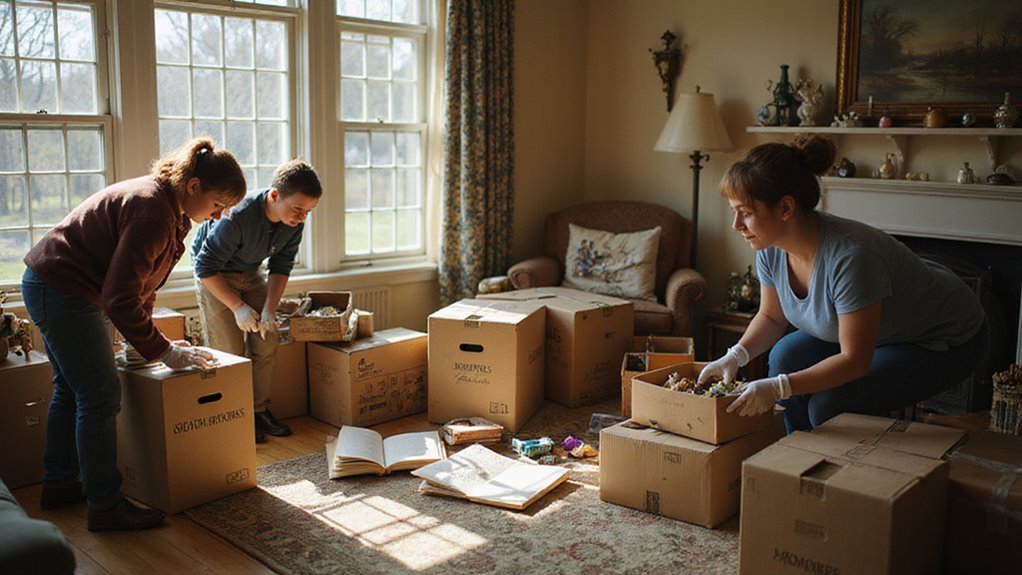
Sentimental belongings can make it hard to move forward. You must make practical choices when preparing a hoarder house for sale. If you hold onto too many emotional items, it can slow your progress.
Start by picking out items that truly matter to you. Ask yourself if each item brings real joy or is just attached to old memories. If an object is meaningful but not needed, consider taking a photo before letting it go. In some cases, you may want to seek help from a professional home buyer who understands how emotional this process can be and offers a straightforward way to move on.
The table below can help you decide what to keep or release. For example, you should keep unique photos and let go of duplicates. If an item is broken or has no connection to your life, it is best to remove it.
If there are multiple owners listed on the deed, make sure everyone agrees on how to handle sentimental items before making final decisions.
Proper Disposal and Junk Removal Services
Efficient disposal is important after sorting sentimental items. It helps keep your home clean and safe. Removing clutter can also make your property more attractive to buyers.
Start by deciding what to throw away, recycle, or donate. If you have bulky items or hazardous waste, contact licensed junk haulers. They can handle heavy lifting and special disposal needs.
Plan your junk removal in stages if you have a lot to clear out. Separate items for recycling or donation to reduce waste. Always follow local rules for disposing of hazardous materials.
Get an itemized quote from each service provider. This will help you manage your budget and avoid surprises. Proper disposal can raise your property’s value and reduce safety risks. If you want to avoid the hassle of junk removal entirely, you can sell your house as-is to reliable buyers who handle everything, making the home selling process convenient and stress-free.
Deep Cleaning Each Room
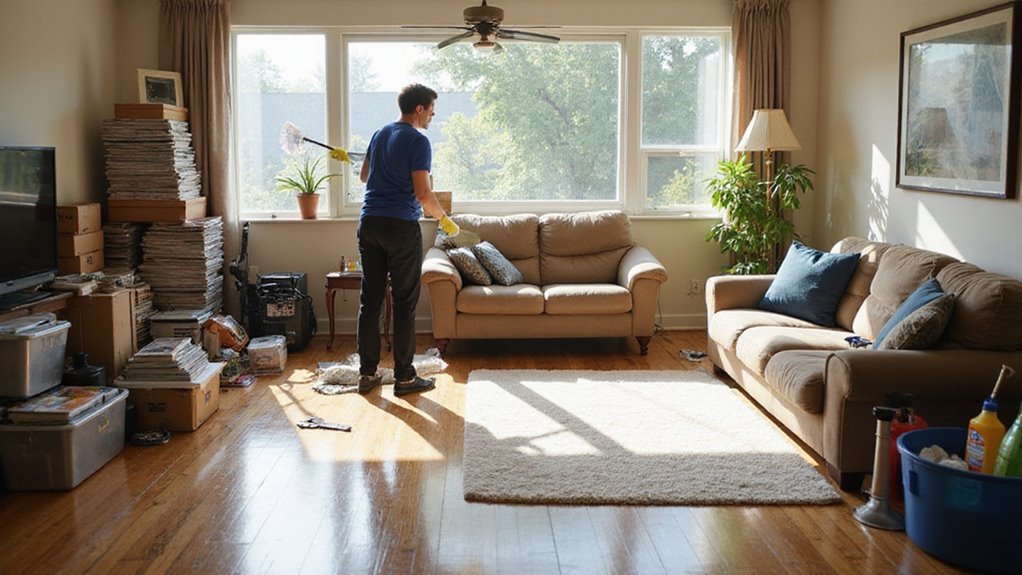
Now that the clutter’s gone, you’ll want to focus on deep cleaning each room, starting with high-traffic areas like kitchens, bathrooms, and hallways. Prioritize these spaces to create immediate impact and ensure safety. Don’t overlook hidden problem spots—behind appliances, under furniture, and inside closets need just as much attention to achieve a truly clean home.
Prioritizing High-Traffic Areas
High-traffic areas get dirty and cluttered quickly. Focus your deep cleaning on entryways, kitchens, bathrooms, and living rooms first. Cleaning these spaces makes your home more appealing to buyers.
Start by removing visible clutter. Put items into piles for donation or disposal if you do not need them. Storage bins, shelves, and baskets can help keep things organized.
Scrub floors, walls, and surfaces to remove dirt and grime. Wash rugs and curtains to help improve air quality. Place everyday items neatly for a tidy look.
If you prioritize these steps, your home will look cleaner and more welcoming. This method can increase your home’s value and attract more buyers.
Addressing Hidden Problem Spots
Hidden problem spots are areas in your home that many people often miss when cleaning. These spots can affect how clean your home really is. If you want your home to look its best, you must address these hidden areas.
Buyers will look inside cupboards, under sinks, and behind appliances. They may notice dirt or damage that you missed if you skip these places. If you clean these hidden spots, your home will make a better impression.
Common trouble areas include behind appliances, inside cabinets and drawers, and under bathroom fixtures. Closets and air vents are also often ignored. Each of these spots can collect dust, dirt, or even mold.
If you clean behind appliances, you can prevent pests and odors. Cabinets and drawers may hide food debris and grime if not cleaned. Under bathroom fixtures, there is a risk of mold and water damage.
Closets collect dust and can cause unpleasant smells. Air vents may spread dust and allergens throughout your house if left dirty. If you tackle these areas, your home will be cleaner and healthier.
Systematically check and clean each problem spot in every room. Remove clutter, scrub surfaces, and look for any needed repairs. If you pay attention to these details, your home will appeal more to buyers.
Repairing Structural and Cosmetic Damage
Repairing structural and cosmetic damage is important before selling your home. Buyers pay attention to the condition of walls, floors, and ceilings. Fixing these areas can increase your home’s value.
Start by checking for water damage, mold, or rot. If you find any, repair them quickly to avoid bigger problems. Walls should be patched if there are holes or cracks.
Check for water damage, mold, or rot and repair these issues promptly to prevent larger, more costly problems down the road.
Replace any broken windows or damaged doors. Faulty hardware should be fixed or swapped out. If your fixtures are old, consider updating them.
Painting the walls in neutral colors can make rooms feel brighter. New paint also gives the home a clean, modern look. Even small updates can help attract buyers.
Tackling Odors and Air Quality Issues
Odors and air quality are important for making a good first impression on buyers. Clean, fresh air helps buyers feel comfortable in your home. If you fix air problems early, buyers are more likely to stay interested.
You should open windows to let in fresh air before showings. Air filtration systems, like HEPA filters, can remove dust and bad smells. If air still smells, deep clean carpets, drapes, and furniture.
Professional odor neutralizers work better than air fresheners for tough smells. Areas with mold, pet urine, or smoke need special cleaning. If these areas are treated well, the home will be more appealing to buyers.
Staging the Home for Showings
Staging helps your home look its best for potential buyers. If you want buyers to take interest, staging is important. Clean rooms and simple decor help people imagine living in the space.
Homeowners should remove extra furniture to make rooms look bigger. Decorative items, like artwork or flowers, add a welcoming touch if used sparingly. Natural light should be used as much as possible, and extra lamps can help brighten dark areas.
Furniture should be arranged to show off special features, such as a fireplace or big window. Clean surfaces and floors show that the home is well cared for. If your home looks fresh and inviting, buyers are more likely to see its value.
Working With Real Estate Professionals
You need a real estate agent who’s handled hoarder properties and understands the unique challenges involved. Partner with them early so you can coordinate cleaning schedules with listing timelines for maximum market impact. Their expertise ensures you don’t miss critical details that could affect your sale.
Finding Experienced Agents
Finding experienced agents means looking for real estate professionals who know how to handle hoarder houses. These agents have dealt with similar properties and understand the unique challenges involved. They can help you sell or rent the house more easily.
If you want a good agent, check if they have worked with hoarder or distressed homes before. Ask for references from people with similar experiences. Make sure the agent knows how to market “as is” properties.
A reliable agent will know local cleaning and restoration companies. The agent should also communicate clearly and handle sensitive talks with buyers or renters. Choosing the right agent gives your property the best chance for a good outcome.
Coordinating Cleaning Timelines
Coordinating cleaning timelines is important for making your property more attractive to buyers. You should plan each cleaning step with your real estate agent. If you schedule these steps well, your home will be ready on time.
Start by removing clutter from every room. Major cleaning and small repairs should follow decluttering. If you have limited time, focus first on areas buyers see right away.
Landscaping and exterior cleaning make a strong first impression. Your agent can suggest when to arrange furniture and clean inside. If you need help, contact cleaners or contractors early.
Set clear deadlines for each task to avoid delays. You should check progress after each phase is finished. If you follow a simple plan, your home will be ready for showings and more likely to sell.
Maintaining the Property During the Selling Process
Maintaining the property during the selling process keeps its value and attracts buyers. Clean and tidy homes make better first impressions.
Buyers are more likely to make strong offers on well-kept properties. A clean, well-maintained home creates great first impressions and encourages buyers to make their best offers.
If possible, store extra items to keep rooms clutter-free. Regular cleaning of busy areas prevents dirt and mess from building up. Quick action on new messes stops problems from growing.
Routine inspections help find small issues before they turn big. Fixing problems early saves time and money. If repairs are needed, address them right away.
Support family members if selling the home feels emotional. Moving can be stressful, so patience is important. If setbacks happen, stay positive and focused on the sale.
Landscaping should look neat for every showing. Fresh paint or clean walkways can boost curb appeal. If possible, check the outside before each visit from buyers.
Conclusion
If you need to sell a hoarder house, a thorough cleaning is important. If you take the time to remove clutter, you can show buyers the true value of the home. If you follow a solid plan, you will make the property more appealing to potential buyers.
If you want to avoid the hassle of cleaning and repairs, we buy houses for cash. If you sell to us, you can skip the long, stressful process of preparing your home for the market. If you prefer a quick solution, we offer a fast and simple sale.
If you are ready to move forward, Freedom Path Investors can help. If you contact us today, we can make you a fair, no-obligation cash offer. If you want to sell your house fast and easily, reach out to Freedom Path Investors now.

